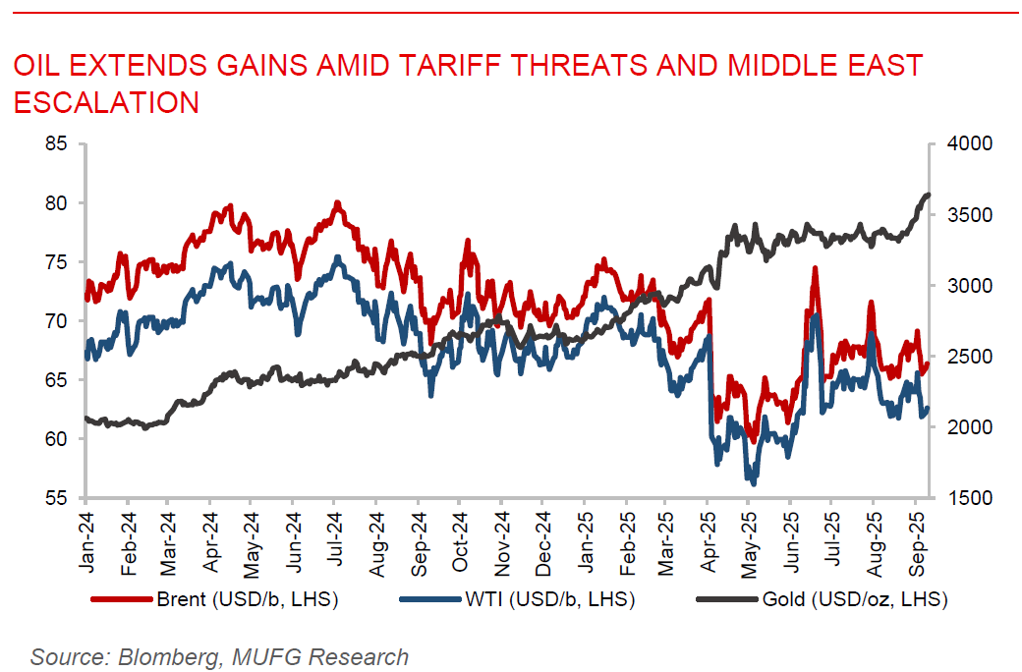To read the full report, please download the PDF above.
Middle East Daily
SOOJIN KIM
Research Analyst
DIFC Branch – Dubai
T: +44(4)387 5031
E: soojin.kim@ae.mufg.jp
MUFG Bank, Ltd. and MUFG Securities plc
A member of MUFG, a global financial group
Middle East Daily
COMMODITIES / ENERGY
Oil extends gains amid tariff threats and Middle East escalation. Oil prices climbed for a third straight session, with Brent nearing USD67/b and WTI around USD63/b, as markets weighed President Trump’s threat of new tariffs on Indian and Chinese buyers of Russian crude alongside heightened geopolitical risks following Israel’s first strike on Qatar. While Brent remains down about 10% YTD amid looming surplus concerns, the attack on Qatar’s capital has revived fears of broader instability in a region supplying a third of global crude, potentially complicating US-led peace efforts. Despite the geopolitical shock, prices haven’t spiked sharply, and Brent's prompt spread narrowed, suggesting the market is still pricing in abundant supply. US data reinforced this outlook, showing inventories swelling earlier than anticipated, while OPEC+ has agreed to add supply modestly next month, underscoring the tension between oversupply fears and geopolitical risk premiums.
Gold holds near record as Fed cut bets and geopolitical risks support demand. Gold steadied near USD3,635/oz, as traders assessed US data showing a potential 911,000 downward payroll revision, strengthening expectations for Fed rate cuts next week. The outlook will hinge on upcoming US inflation data, with easing fully priced in by markets. Geopolitical risks added further support, with Israel’s strike on Hamas leaders in Qatar and Trump’s threats of new tariffs on India and China fuelling safe-haven demand. Gold has already gained almost 40% this year, underpinned by central bank purchases, and concerns over Trump’s tariff agenda and Fed independence. With central banks in China, India, and Europe continuing to boost reserves, official sector demand is expected to remain a key driver of gold’s upward momentum.
MIDDLE EAST - CREDIT TRADING
End of day comment – 9 September 2025. Another strong session overall. The spread tightening is on as cash prices were unaffected by higher UST yields. Buyers still outstripping sellers in terms of flows and the short covering in higher beta credits remains on. OMAN was higher in cash, anywhere from 0.125-0.5pt and closed another 8bp tighter on average. The QATAR/ Israel news saw some selling from international RM, but it was short lived and not sizeable enough to move prices lower. In fact QATAR closed also tighter on the day with cash prices in the sovereign curve unchanged and spreads 2-4bp tighter. In the financial space new FABUH 30s squeezed tighter on light buying meeting no sellers, closing bonds +0.375pt/-10bp. Doha Bank will price its new long 5.5y at T+105bp (500mm) which barring any negative news overnight related to the Israel strike in Doha will be well received. Like mentioned yesterday the market in MENA is in need for new supply away from the Saudi complex. Spreads look tight as ever, yields even lower with the UST move lately, and yet there are no willing sellers. The incremental inflows can still take the market tighter from here.
MIDDLE EAST - MACRO / MARKETS
Saudi PIF raised USD2bn in 10-year bond amid surge in issuance. Saudi Arabia’s Public Investment Fund (PIF) sold USD2bn of 10-year dollar bonds on 8 September, priced at 95bps over US Treasuries, reflecting strong investor demand with orders exceeding USD7.5bn. The deal follows the fund’s USD4bn debt sale in January and a USD7bn Islamic loan, underscoring its push to secure financing for Vision 2030 projects amid weaker oil revenues. The IMF expects the PIF to maintain annual domestic spending of at least USD40bn, sustaining growth while driving diversification. Recent moves, including a commercial paper program, asset stake sales, and potential IPOs of portfolio companies, highlight PIF’s active capital-raising strategy. This issuance adds to a broader wave of Saudi borrowing, including USD20bn in sovereign debt this year, making the Kingdom the largest emerging market borrower in 2025 as entities move quickly to tap markets before potential volatility in global debt conditions.
EBRD, GCF, and EU provide USD50 million green and trade finance package to Egypt. The European Bank for Reconstructions and Development (EBRD), the Green Climate Fund (GCF), and the European Union (EU) have unveiled a comprehensive USD50 million financing package with Egypt’s Suez Canal Bank (SCB) to advance green transition and trade expansion. The package includes a USD25 million loan under EBRD’s Green Economy Financing Facility to expand on-lending for households and MSMEs investing in climate adaptation and mitigation technologies, alongside an uncommitted USD25 million increase to the bank’s trade finance limit for guarantees and cash advances. Additionally, the EU will provide up to USD2.9 million in incentive grants for borrowers who successfully implement green projects. This agreement reflects Egypt’s broader green transition strategy and builds on the EBRD’s record financing in 2024, when it invested EUR1.5bn in Egypt, nearly half in green projects. Since 2012, the EBRD has invested EUR13.8bn across 194 projects in Egypt, underscoring its long-term commitment to supporting Egypt’s sustainable growth.

